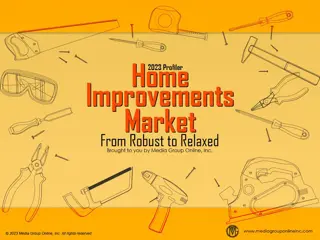Home Improvement Industry Insights 2018
In 2018, the home improvement industry experienced growth with total sales surpassing forecasts. However, a volatile housing market poses a challenge for future growth. Major players like Lowe's, Home Depot, and Ace Hardware saw varying performance. Consumers are willing to spend on home improvements, with different age groups showing varying trends. Online purchases of home improvement products are on the rise, indicating a shift towards digital retail channels.
Uploaded on Sep 11, 2024 | 0 Views
Download Presentation

Please find below an Image/Link to download the presentation.
The content on the website is provided AS IS for your information and personal use only. It may not be sold, licensed, or shared on other websites without obtaining consent from the author.If you encounter any issues during the download, it is possible that the publisher has removed the file from their server.
You are allowed to download the files provided on this website for personal or commercial use, subject to the condition that they are used lawfully. All files are the property of their respective owners.
The content on the website is provided AS IS for your information and personal use only. It may not be sold, licensed, or shared on other websites without obtaining consent from the author.
E N D
Presentation Transcript
2018 Continued the Markets Growth At the beginning of 2018, the North American Retail Hardware Association (NRHA) forecasted total 2018 industry sales at $391.2 billion; however, the final total was $394.6 billion, a 4.5% increase from 2017. The Home Improvement Research Institute (HIRI) reported a larger total sales figure, or $398.2 billion, a 6.3% increase over its 2017 total sales of $374.8 billion. With a robust housing and remodeling market during the first half of 2018, home improvement sales from professionals purchases increased 9.9% for the year while consumers spent 4.7% more for home improvement products.
A Volatile Housing Market Could Slow Home-Improvement Growth The major challenge for the home improvement industry is the current state of residential real estate sales, as new-home sales declined significantly during November and December, at 4.6% and 11.6%, respectively. Realtor.com forecasts mortgage rates will average 5.3% throughout 2019 and home prices will increase 2.2%, which is less of an increase than during the end of 2018. All of which leads to a - 2.2% forecast for 2019 existing home sales. The Joint Center for Housing Studies of Harvard University (JCHS) is predicting a 5.1% increase in renovation and repair spending for owner-occupied homes, but this is significantly less than 2018 s 7.5% increase.
Lowes Is Struggling the Most Among the Top Chains Of the big-three home improvement chains, Lowe s Q3 2018 financial report was the most troubling. Although total sales were $17.4 billion, a 3.8% increase over Q3 2017, its net earnings of $872 million were 27% less than Q3 2017. Home Depot s Q3 2018 total sales were $26.3 billion, a 5.1% increase from Q3 2017, while net earnings totaled $2.9 billion, a 31.8% increase from Q3 2017 s $2.2 billion. Home Depot plans to open approximately 170 new distribution centers. Ace Hardware also had a good Q3 2018, with total sales of $1.43 billion, a 6.3% from Q3 2017. Although net income plummeted from 53.8 million for Q3 2017 to $36.3 million for Q3 2018, online sales increased 35%.
Consumers Happy to Spend on Home Improvements According to HomeAdvisor s (March) 2018 True Cost Report, homeowners spent an average of $6,649 on home improvements per household during the last 12 months. Although Millennials were more likely than any other age group to remodel their homes and have completed the most home projects during the past 12 months, Baby Boomers spent the most money on home projects, 32% more than Millennials. In its Q4 2018 Project and Sentiment Tracking Survey, HIRI reported there was 6% less project planning during the quarter compared to Q4 2017. In addition, more than 25% of homeowners are planning lawn and garden and/or landscaping projects for Q1 2019.
Many Home-Improvement Products Are Easy to Purchase Online According to HIRI s Role of Social Media in Home Improvement study, 22% of the 750 homeowners surveyed said they had bought a home-improvement product online via a link from social media to a seller s site. Another 39% said they would consider it. A TraQline 2018 survey found 81% of power tools are bought in brick-and-mortar stores, with Home Depot, Lowe s and Sears the top three. 60% of survey participants said pricing was their first factor when deciding to buy a tool. The L.E.K. Consulting Ecommerce in Home Improvement 2018: Ready or Not report states ecommerce has an increasing share of the home- improvement market, especially among Millennial contractors who purchase 50% more online than older contractors.
A Focus on Favorable Target Audiences Although researched to death, Millennials are still the prime target of the home-improvement industry. Marvin Ellison, president and CEO of Lowe s, views Millennials as a huge opportunity for the industry, as more of them can afford to buy a home. A good consumer sector for home-improvement and hardware stores is renters, especially those living in costly residences. JCHS reports 40% of new apartments had rents of $1,500 or more. According to Nielsen, Millennials are more likely to be DIYers. Almost 25% of Americans made home improvements during 2018 and 63% did their projects themselves. DIYers are very likely to use digital devices, especially to access YouTube DIY videos.
Advertising Strategies According to an article in Hardware Retailing, home-improvement and hardware stores (as many do) can maximize foot traffic and sales by attracting seasonal and impulse shoppers, and not just the obvious holidays, but also lesser seasons. Make sure you check the Co-op>Connect database on the Media Group Website for co-op dollars, especially for smaller and local home-improvement and hardware stores/chains to help them compete with Home Depot, Lowe s, etc. With more apartment dwellers, especially in upscale residences, recommend that stores contact management companies to host onsite seminars/DIY sessions to take advantage of the large concentration of potential customers who wouldn t have to leave the community.
New Media Strategies With more Millennials as homeowners, any store can distinguish its brand with a proactive and aggressive use of social media to share DIY tips and ideas. Videos are the prime content method, especially for younger adults. With more mobile consumers of all ages , consider a You Could Be Returning to a More Welcoming Home promotion, sharing photos and videos of products and looks that would encourage those mobile consumers to choose products to improve their homes. As more Millennials become homeowners, consider conducting regular polls/surveys to determine what products would capture their attention, which are likely to be quite different than what older consumers have been buying.























